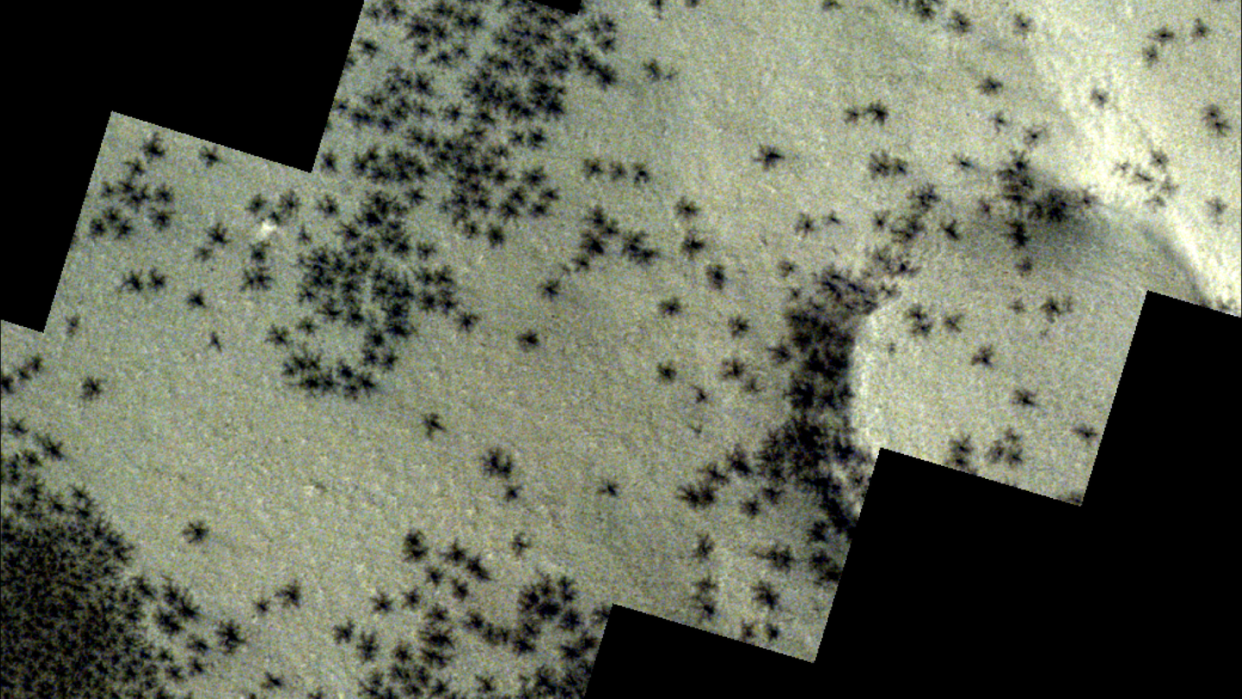An Unsettling New Image Shows ‘Spiders’ on Mars

As Mars’ polar ice caps warm up, sublimated CO2 gas explodes out in tall geysers, forming spider-like formations in their wake.
The European Space Agency’s Trace Gas Orbiter captured these “spiders” with stunning clarity near a south polar region called Angustus Labyrinthus, called “Inca City.”
The Trace Gas Orbiter is the first of two spacecraft that make up the ExoMars mission, including the indefinitely delayed Rosalind Franklin Mars rover.
Mars is home to many amazing topographical sites. There’s the Hellas Planitia, which is roughly twice the size of Alaska and may be the largest impact crater in the Solar System. There’s Olympus Mons—the largest extinct volcano in the Solar System, which is roughly the size of Arizona (U.S. states offer good Martian size equivalents, apparently). However, one of the creepiest, crawliest features on the red planet are the seasonal “spiders” that appear at Mars’ poles throughout the year.
These “spiders” were captured by the CaSSIS (Colour and Stereo Surface Imaging System) instrument aboard the European Space Agency’s (ESA) ExoMars Trace Gas Orbiter, which is on a mission to investigate traces of methane and other gasses present in small amounts in the Martian atmosphere. This image was close to a region in the near the Martian south pole called Angustus Labyrinthus—nicknamed “Inca City,” due to the nearby geologic formations—which was likely caused by past glaciers or magma activity and resembles a ruined city (don’t get any ideas).
While the pop-culture Spiders From Mars were David Bowie’s backing band in the 1970s, the real spiders from Mars are a complex geological phenomenon that happens when the Mars’ southern pole warms up during springtime. It may not seem like it, considering its overall redness, but Mars also experiences four seasons. Each one is roughly twice as long as one of Earth’s, and that are made most evident by the planet’s encroaching and receding (and sometimes disappearing) polar ice caps.
During the winter, ice made from carbon dioxide—the primary gas found in Mars’ thin atmosphere—forms on the surface. When things start to warm up in the spring, CO2 from the bottom layer begins turning into gas, which eventually breaks through the top layers of ice. This drags dark material up to the surface, and can shatter ice layers up three feet thick, according to the ESA.
Then, the fun really begins. Tall fountains, or geysers, explode through these cracks, and the dark dust eventually falls back to the surface. This can create dark spots ranging from 65 meters to 1 kilometer wide in the form of, you guessed it, spiders.
Understanding these “spiders” is part of the orbiter’s primary mission, which is to evaluate seasonal changes in Mars’ atmospheric composition and help scientists craft accurate weather models. The orbiter was the first of two spacecraft in a collaboration between ESA and Roscosmos, Russia’s space agency. The second is Rosalind Franklin, ESA’s Martian lander, which was supposed to be launched in 2020 before it was delayed due to the COVID-19 pandemic. After Russia invaded Ukraine in early 2022, ESA severed ties with Roscosmos, and the rover is now delayed until 2028 while the space agency searches for a new launch platform.
So, while Rosalind Franklin will be late to the Martian party, the Trace Gas Orbiter is having a get-together of its own with the spiders from Mars.
You Might Also Like

